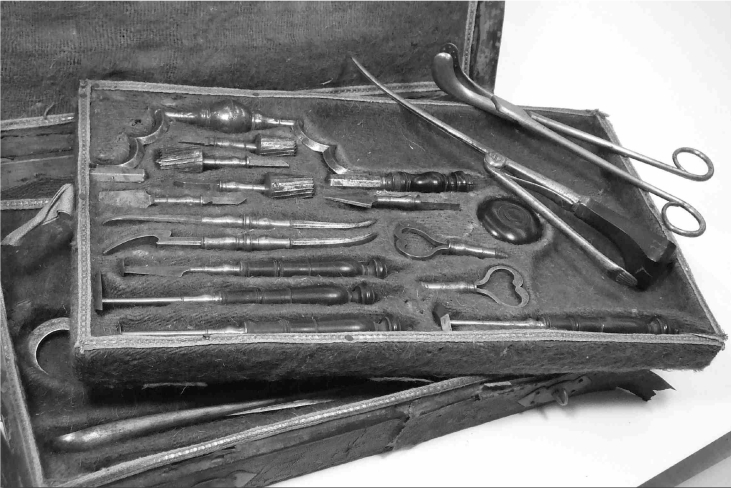At first glance, the highly technical procedures and specialization that characterize 21st-century surgery bear little resemblance to the craft as practiced in Renaissance France and Italy or in the 19th-century operating theaters of Paris, London, or Philadelphia. Yet continuities in Western medical traditions link contemporary surgery to its professional predecessors. To understand the way surgery is practiced today, it is helpful to examine these historical roots. A peek into the cabinets that house and preserve historical surgical instruments reveals both continuities and differences. The evolution of surgical instruments tells the history of surgery in tangible ways, as the photographs in this piece demonstrate.
Surgery always has been intimately connected with its instruments. From the square-sectioned iron needle that the Roman surgeon Celsus recommends for couching cataracts to the remote-control laser scalpels used today, instruments both serve the surgeon and influence how procedures can be conducted. Surgical innovations have come about not only as a result of increased knowledge or technical expertise, but also for more practical reasons. Surgeons modified their instruments in an effort to grasp, manipulate, or cut more effectively. The frequent need to carry instruments onto a battlefield imposed limits on size, weight, and durability, leading to changes in the surgeon’s tool kit. The wartime surgeon, for example, selected instruments that naturally would cater to trauma and preferred versatile instruments over narrowly specialized ones. Historical instruments speak to a chronicle of surgical practicalities — what was done, how it was done, and what compromises were made as various needs and desires were played against each other [1].
The instruments shown here relate to surgery from the late Renaissance to the 20th century. A series of three syringes and four surgical kits demonstrates that even as design and packaging changed, surgeons relied on many of the same instruments to perform their work. Practitioners demanded precise and well-crafted instruments, a demand reflected in the quality and durability of these examples. These instruments also illustrate differences between various national surgical traditions and between Renaissance, early modern, and modern professional practices. But most importantly, they invite 21st-century observers to imagine surgery in the past, from both the perspective of the surgeon and the patient.
The instruments chosen for this piece are all part of the collections of the Cushing-Whitney Medical Historical Library at Yale University. The library possesses an unusually wide range of materials other than books. The Streeter Collection of Weights and Measures is especially well-known, and there are collections of prints, medallions, seal matrices, coins, scientific instruments and medical instruments and paraphernalia. These are primarily due to many decades of donations that have come from deliberate collection, incidental acquisitions during a donor’s career or travels, and Yale departments casting off obsolete apparatus. The collections overall are both rich and broad and can support study of various periods, places, people, and practices [2].
For more information on the surgical instruments collection at Yale University School of Medicine, please visit http://bin.yale.edu/~amk36/ or contact alistair.kwan@yale.edu.
Figure 1.
An ophthalmologic surgery kit from the 17th century contains exchangeable blades.
Figure 2.
An ornate general surgery kit from the 18th century includes skull drills, tools for the cauterization of wounds, and other specialty tools.
Figure 3.
A 19th-century surgical kit features bone handles, a variety of specialized blades, suturing needles, and clips to stem the flow of blood from minor vessels.
Figure 4.
This surgical set produced by Tiemann Company was received from a donor who claimed it was a Civil War battlefield kit. It includes a bone rasp, large saw, and blades designed for amputation.
Figure 5.
This syringe kit produced in Berlin is from the war period and features morphine and strychnine doses in grams and grains.
Figure 6.
This hypodermic syringe was made by Becton Dickinson with “resistance glass.”
Figure 7.
A tuberculin injection syringe with dosage table.
References
- Kirkup J, Edmonson JM. The Evolution of Surgical Instruments: An Illustrated History from Ancient Times to the Twentieth Century. Novano, CA: Norman Publishers; 2006. [Google Scholar]
- Edmonson JM. American Surgical Instruments: The History of Their Manufacture and a Directory of Instrument Makers to 1990. Novano, CA: Norman Publishers; 2006. [Google Scholar]









